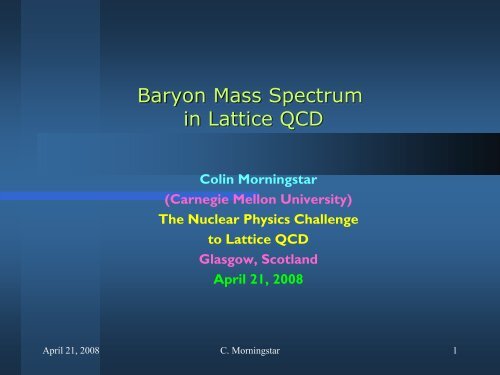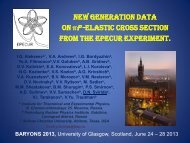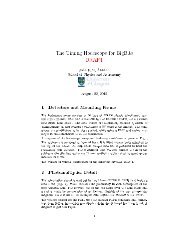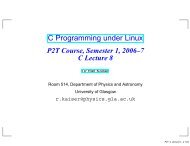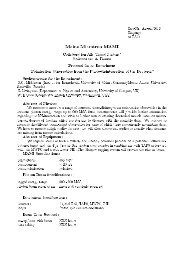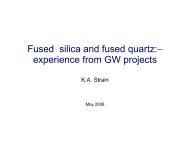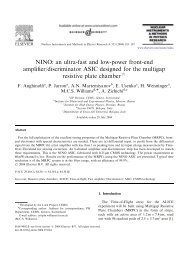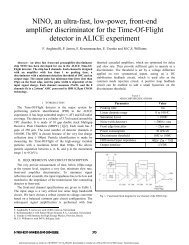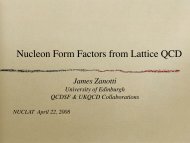Colin Morningstar - Nuclear Physics
Colin Morningstar - Nuclear Physics
Colin Morningstar - Nuclear Physics
- No tags were found...
You also want an ePaper? Increase the reach of your titles
YUMPU automatically turns print PDFs into web optimized ePapers that Google loves.
Baryon Mass Spectrumin Lattice QCD<strong>Colin</strong> <strong>Morningstar</strong>(Carnegie Mellon University)The <strong>Nuclear</strong> <strong>Physics</strong> Challengeto Lattice QCDGlasgow, ScotlandApril 21, 2008April 21, 2008 C. <strong>Morningstar</strong>1
Overarching goal• goal: ab initio determination of hadron mass spectrum from QCD• use of Markov-chain Monte Carlo estimates of path integralsnecessitates space-time lattice regularizationL QCDLagrangian ofQCDhadronspectrum,structure,transitionsApril 21, 2008 C. <strong>Morningstar</strong>2
Collaborators• A. Lichtl (Brookhaven Nat. Lab.)• J. Bulava, C. <strong>Morningstar</strong>, J. Foley (Carnegie Mellon U.)• J. Dudek, R. Edwards, B. Joo, H.W. Lin, D. Richards (Jefferson Lab.)• S. Wallace (U. Maryland)• K.J. Juge (U. of Pacific)• N. Mathur (Tata Institute)• M. Peardon, S. Ryan (Trinity Coll. Dublin)April 21, 2008 C. <strong>Morningstar</strong>3
Energies from correlation functionsφ()t• choose operator to create state of interest from vacuum• evaluate temporal correlationsHt−Ht• imaginary-time evolution φ( t)= e φ(0)e ( H = Hamiltonian)• spectral representation∑n∑0 φ( t) φ(0) 0 = 0 e φ(0) e n n φ(0) 0nA11E0• extract and E − asHt−Ht∑2 −( 0) ( 0)n (0) 0 en− −φA en−= =t → ∞Ct () = 0 φ() tφ(0)0E E t E E tnn(assuming 0 φ(0)0 = 0 and 1φ(0)0 ≠ 0 )insert complete set ofenergy eigenstates(discrete and continuous)April 21, 2008 C. <strong>Morningstar</strong> 4
Monte Carlo method• hadron operators φ = φψ [ , ψ, U ] ψ =quark U =gluon field• temporal correlations from path integrals−ψM [ U] ψ−S[ U]D[ ψψ , , U] φ( t) φ(0)eφ() t φ(0)−ψMU[ ] ψ−SU[ ]D[ ψψ , , U]e= ∫ ∫• integrate exactly over quark Grassmann fieldsφ() t φ(0)−( )DU det M[ U ] M [ U ] e= ∫ ∫DU det M[ U ] e1 −SU[ ]−SU[ ]• resort to Monte Carlo method to integrate over gluon fields• generate sequence of field configurations U1, U2, U3, , UNusing Markov chain procedure use of parallel computations on supercomputers especially intensive as quark mass (pion mass) gets smallApril 21, 2008 C. <strong>Morningstar</strong>5
Lattice regularization• hypercubic space-time lattice regulator needed for Monte Carlo• quarks reside on sites, gluons reside on links between sites• lattice excludes short wavelengths from theory (regulator)• regulator removed using standard renormalization procedures(continuum limit)• systematic errors discretization finite volumequarksgluonsApril 21, 2008 C. <strong>Morningstar</strong>6
Spectroscopy efforts• extracting spectrum of resonances is big challenge• challenge on two fronts:Markov chain Monte Carlo generation of configurationshadron operator design to “tease out signal”• focus on operator design/correlator evaluation hereneed sets of extended operators (correlator matrices)multi-hadron operators needed toonew techniques using stochastic all-to-all quark propagators• long-term (multi-year) effortApril 21, 2008 C. <strong>Morningstar</strong>7
Effective mass⎛ C(t)⎞• the “effective mass” is given by meff( t)= ln⎜⎟⎝ C(t + 1) ⎠• notice that (take E 0= 0 )⎛−Et1 −E2tAe 1 + A2e+ ⎞Elim ( ) ln 1t→∞ m t = ⎜1 ( 1)ln e E− E t+⎟→ =⎝ Ae 1 + ⎠• tends to the actual mass (energy) asymptotically• convenient visual tool to see signal extractionseen as a plateau• plateau sets in quicklyfor good operator• excited-statecontamination beforeplateaueff 1April 21, 2008 C. <strong>Morningstar</strong>8
Matrices of correlators• extracting excited-state energies requires matrix of correlators• for a given N × N correlator matrix Cαβ () t = 0 O () t O+α β (0)0one defines the N principal correlators t,t ) as the eigenvalues oft 0C(t−1/2−1/20) C(t)C(t0)λ α (0where (the time defining the “metric”) is small−(t−t0 ) Eα−tΔEα• can show that limt→ ∞λ α ( t,t0)= e (1 + e )eff ⎛ λα( t,t0)⎞• N principal effective masses defined by mα( t)= ln⎜⎟⎝ λα( t + 1, t0)⎠now tend (plateau) to the N lowest-lying stationary-state energiesApril 21, 2008 C. <strong>Morningstar</strong>9
Unstable particles (resonances)• our computations done in a periodic boxmomenta quantized discrete energy spectrum of stationarystates single hadron, 2 hadron, …• “ferret” out resonances from scattering states differentiate resonances from multi-hadron states know masses of decay products placement and pattern ofmulti-particle states known resonances states with little volume dependenceApril 21, 2008 C. <strong>Morningstar</strong>10
Operator design issues• statistical noise increases with temporal separation t• use of very good operators is crucial or noise swamps signal• recipe for making better operatorscrucial to construct operators using smeared fields– link variable smearing– quark field smearingspatially extended operatorsuse large set of operators (variational coefficients)April 21, 2008 C. <strong>Morningstar</strong>11
Three stage approach ( PRD72:094506,2005 )• concentrate on baryons at rest (zero momentum)• operators classified according to the irreps ofG G , G , G , H , H• (1) basic building blocks: smeared, covariant-displaced quark fields~ ( p)( D ~ ψ ( x))p - link displacement ( j = 0, ± 1, ± 2, ± 3)• (2) construct elemental operators (translationally invariant)F F ( p) ( p) ( p)B ( x) = φ ε ( D ψ( x)) ( D ψ( x)) ( Dψ( x))j1g,1u2g2uAaαflavor structure from isospincolor structure from gauge invarianceguO hABC abc i Aaα j Bbβ k Ccγ• (3) group-theoretical projections onto irreps ofΛλFdΛ( Λ)∗ FBi( t)∑ Dλλ( R)URBi( t)Ug DApril 21, 2008 C. <strong>Morningstar</strong>12O h+=RODhR∈Oh
Three-quark elemental operators• three-quark operatorΦ =∑ ABC( p) A ( p) B ( p)Cαβγ , ijk ( t) εabc( Di ψ( xt , )) aα ( Dj ψ( xt , )) bβ ( Dkψ( xt , )) cγx• covariant displacements( p)D ( x, x′ ) = U ( x) U ( x+ ˆj) U( x+ ( p− 1) ˆj) δ ( j =± 1, ± 2, ± 3)Dj j j j x′ , x+pj ˆ( p)0( x, x′ ) = δx′, xBaryon++Δ+ΣN + 0Ξ0Λ−ΩOperatorΦΦuu uΦ αβγ ,ijkus uΦ αβγ ,ijkuud duuαβγ , ijk −Φαβγ, ijksu sΦ αβγ ,ijkuds dusαβγ , ijk −Φαβγ, ijkss sΦ αβγ ,ijkApril 21, 2008 C. <strong>Morningstar</strong>13
Incorporating orbital and radial structure• displacements of different lengths build up radial structure• displacements in different directions build up orbital structureΔ-fluxbaryonsY-fluxmesons• operator design minimizes number of sources for quark propagators• useful for mesons, tetraquarks, pentaquarks even!• can even incorporate hybrid meson operatorsApril 21, 2008 C. <strong>Morningstar</strong>14
Enumerating the three-quark operators• lots of operators (too many!)++ −,Δ Ω+ 0Σ , Ξ N + Λ0Single-site 20 40 20 24Singly-displaced 240 624 384 528Doubly-displaced-I 192 572 384 576Doubly-displaced-L 768 2304 1536 2304Triply-displaced-T 768 2304 1536 2304Triply-displaced-O 512 1536 1024 1536April 21, 2008 C. <strong>Morningstar</strong>15
Spin identification and other remarks• spin identification possible by pattern matchingtotal numbers of operators assuming twodifferent displacement lengths• total numbers of operators is huge uncharted territory• ultimately must face two-hadron scattering statesApril 21, 2008 C. <strong>Morningstar</strong>16
Single-site operators• choose Dirac-Pauli convention for γ-matricesApril 21, 2008 C. <strong>Morningstar</strong>17
Δ++ single-site operatorsApril 21, 2008 C. <strong>Morningstar</strong>18
Single-site N+ operatorsApril 21, 2008 C. <strong>Morningstar</strong>19
Testing the three-quark operators• Next step: smearing optimization and operator pruningoptimize link-variable and quark-field smearingsremove dynamically redundant operatorsremove ineffectual operatorslow statistics runs in quenched approx on small latticesApril 21, 2008 C. <strong>Morningstar</strong>20
Importance of smearing•Nucleon G 1g channel•effective masses of 3selected operators•noise reduction fromlink variable smearing,especially for displacedoperators•quark-field smearingreduces couplings tohigh-lying statesσ snρ= 4.0, nσ= 32ρ = 2.5, n = 16•less noise in excitedstates using σ = 3.0sρ(t)1.5Single-Site1(t)M iM i(t)0.5Quark Smearing Only00 10 201.5 t / a t1(t)M iM i(t)0.5Link Smearing Only00 10 201.5 t / a t1(t)M iM i0.5Both Quark and Link Smearing00 10 20t / a t1.510.5Singly-Displaced(t)M i00 10 201.5 t / a t10.5(t)M i00 10 201.5 t / a t10.5(t)M i1.5Triply-Displaced-T10.500 10 201.5 t / a t10.500 10 201.5 t / a t10.5000 10 20 0 10 20t / a tt / a tApril 21, 2008 C. <strong>Morningstar</strong>22
Operator plethora (G 1g Nucleon)1 Single Site Operator 01 Single Site Operator 11Three-Link Singly Displaced Operator 40.90.90.90.90.80.80.80.80.70.70.70.7a tM eff0.60.50.4a tM eff0.60.50.4a tM eff0.60.50.41 Three-Link Singly Displaced Operator 3 ta tM eff0.60.50.40.30.30.30.3a tM eff0.20.100 5 10 15 20 25 30t/a t1 Single Site Operator 20.90.80.70.60.50.40.30.20.100 5 10 15 20 25 300.90.8t/a ta tM eff0.20.20.10.100 5 10 15 20 25 30t1 Three-Link Singly Operator 5t/a tt/at/a1 Three-Link Singly Displaced Operator 2 1 Three-Link Singly Displaced Operator 81 Three-Link Singly Displaced Operator 0Displaced 1 Three-Link Singly Displaced Operator 60.90.90.80.80.70.70.60.60.50.50.40.40.30.30.20.20.10.10000 5 10 15 20 25 300 5 10 15 20 25 30t/a tt/a tt/at0.90.80.70.60.50.40.30.20.1a tM eff00 5 10 15 20 25 300.90.90.90.80.80.8a tM eff0.20.100 5 10 15 20 25 300 5 10 15 20 25 300.70.70.70.7a tM eff0.60.50.41 Three-Link Singly Displaced Operator 1 ta tM eff0.60.50.4a tM eff0.60.50.41 Three-Link Singly Displaced Operator 7 ta tM eff0.60.50.40.30.30.30.30.20.20.20.20.10.10.10.100 5 10 15 20 25 30t/a t00 5 10 15 20 25 30t/a00 5 10 15 20 25 30t/a t00 5 10 15 20 25 30t/aApril 21, 2008 C. <strong>Morningstar</strong>23
G 1g nucleon operators1 Three-Link Singly Displaced Operator 101 Three-Link Singly Displaced Operator 16a tM effa tM effa tM efft0.90.90.90.90.80.80.80.80.70.70.70.70.60.60.60.60.50.50.50.50.40.40.40.40.30.30.30.30.20.20.20.20.10.10.10.100000 5 10 15 20 25 300 5 10 15 20 25 300 5 10 15 20 25 30t/a tt/at/attt/a1 Three-Link Singly Displaced Operator 9 1 Three-Link Singly Displaced Operator 151 Three-Link Singly Displaced Operator 13 1 Three-Link Singly Displaced Operator 14 1 Three-Link Singly Displaced Operator 19 1 Three-Link Singly Displaced Operator 201 Three-Link Singly Displaced Operator 11 1 Three-Link Singly Displaced Operator 121 Three-Link Singly Displaced Operator 17 1 Three-Link Singly Displaced Operator 180.90.90.90.90.80.80.80.80.70.70.70.70.60.60.60.60.50.50.50.50.40.40.40.40.30.30.30.30.20.20.20.20.10.10.10.100000 5 10 15 20 25 300 5 10 15 20 25 300 5 10 15 20 25 30t/a tt/at/attt/at0.90.90.90.90.80.80.80.80.70.70.70.70.60.60.60.60.50.50.50.50.40.40.40.40.30.30.30.30.20.20.20.20.10.10.10.100000 5 10 15 20 25 300 5 10 15 20 25 300 5 10 15 20 25 30t/a tt/at/a tt/atta tM effa tM effa tM effa tM effa tM effa tM effa tM effa tM effa tM eff0 5 10 15 20 25 300 5 10 15 20 25 300 5 10 15 20 25 30April 21, 2008 C. <strong>Morningstar</strong>24
H u nucleon operatorsa tM effa tM effa tM eff1 Three-Link Triply Displaced T Operator 351 Three-Link Singly Displaced Operator 1 1 Three-Link Triply Displaced T Operator 371 Single Site Operator 01 Three-Link Singly Displaced Operator 00.90.90.90.80.80.80.70.70.70.60.60.60.50.50.50.40.40.40.30.30.30.20.20.20.10.10.100000 5 10 15 20 25 300 5 10 15 20 25 300 5 10 15 20 25 30t/a tt/a tt/att/at1 Three-Link Singly Displaced Operator 3 1 Three-Link Singly Displaced Operator 4 1 Three-Link Triply Displaced T Operator 391 Three-Link Singly Displaced Operator 20.90.90.90.80.80.80.70.70.70.60.60.60.50.50.50.40.40.40.30.30.30.20.20.20.10.10.100000 5 10 15 20 25 300 5 10 15 20 25 300 5 10 15 20 25 30t/a tt/at/a tt/att0.90.90.90.80.80.80.70.70.70.60.60.60.50.50.50.40.40.40.30.30.30.20.20.20.10.10.100000 5 10 15 20 25 300 5 10 15 20 25 300 5 10 15 20 25 30t/at/a tt/att/att0.90.80.70.60.50.40.30.20.10.90.80.70.60.50.40.30.20.10.90.80.70.60.50.40.30.20.1a tM effa tM effa tM effa tM effa tM effa tM effa tM effa tM effa tM eff1Three-Link Triply Displaced T Operator 360 5 10 15 20 25 301Three-Link Triply Displaced T Operator 380 5 10 15 20 25 301Three-Link Triply Displaced T Operator 400 5 10 15 20 25 30April 21, 2008 C. <strong>Morningstar</strong>25
Operator selection• rules of thumb for “pruning” operator setsnoise is the enemy!prune first using intrinsic noise (diagonal correlators)prune next within operator types (single-site, singly-displaced,etc.) based on condition number of prune across all operators based oncondition number• best to keep a variety of different types of operators, as long ascondition numbers maintainedˆCij() tCij() t = , t = 1Cii() t Cjj() t• typically use 16 operators to get 8 lowest lying levelsApril 21, 2008 C. <strong>Morningstar</strong> 26
Nucleon G 1g effective masses• 200 quenched configs, 12 3 48 anisotropic Wilson lattice, a s ~0.1 fm,a s /a t ~3, m π ~700 MeV• nucleon G 1g channel• green=fixed coefficients, red=principalApril 21, 2008 C. <strong>Morningstar</strong>27
Nucleon H u effective masses• 200 quenched configs, 12 3 48 anisotropic Wilson lattice, a s ~0.1 fm,a s /a t ~3, m π ~700 MeV• nucleon H u channel• green=fixed coefficients, red=principalApril 21, 2008 C. <strong>Morningstar</strong>28
MILESTONE 1Single-hadron excitations in quenched approximationApril 21, 2008 C. <strong>Morningstar</strong> 29
Nucleon spectrum• 200 quenched configs, 12 3 48 anisotropic Wilson lattice, a s ~0.1 fm,a s /a t ~3, m π ~700 MeVApril 21, 2008 C. <strong>Morningstar</strong>30
Delta spectrum• 200 quenched configs, 12 3 48 anisotropic Wilson lattice, a s ~0.1 fm,a s /a t ~3, m π ~700 MeV (preliminary)April 21, 2008 C. <strong>Morningstar</strong>31
MILESTONE 2Single-hadron excitations for N f =2April 21, 2008 C. <strong>Morningstar</strong> 32
Inclusion of quark loops• Left: N f =0 m π =700 MeV• Right: N f =2 m π =400 MeV (only two channels analyzed so far)April 21, 2008 C. <strong>Morningstar</strong>33
Baryon correlator• consider a temporal correlator of a three-quark Σ (uus) baryon:1C () t = c c( ΣΛλ) ( ΣΛλ)( l) ( ΣΛλ)( l ) ∗4 4 4lp| lp αβγ ; ijk αβγ ; ijk abc abc γ ′ γ ββ ′ α′αNttx x0u( x, ; x, | ) ( x, ; x, | )× Q t+ t t U Q t+t t U( u) ( )aαip; aα′ ip 0 0 bβ jp;bβ′jp0 0u( x, +0; x, 0| ) − ( x, +0; x, 0| )s( x, t+ t ; x, t | U) Q ( x, t+t ; x,t | U)Q t t t U Q t t t UQ∑ ∑ ∑( s) ( )cγkp; cγ′ kp aαip;bβ′jpε ε γ γ γ( u) ( )bβjp;aα′ip 0 0 cγkp;cγ′kp0 0• above expression needs quark propagators from all spatial sites xon time slice t 0 to all spatial sites x on time slice t+t 0UApril 21, 2008 C. <strong>Morningstar</strong> 34
All-to-all stochastic quark propagators 1 • baryon at rest is operator of form B( p= 0, t) = ∑ϕB( x, t)V x• baryon correlator has a double spatial sum10 B( p = 0, t) B( p = 0,0) 0 = 0 ( , ) ( ,0) 02 ∑ ϕBx t ϕByV xy ,• computing all elements of propagators exactly not feasible• translational invariance can limit summation over source site to asingle site for local operators10 B( p = 0, t) B( p = 0,0) 0 = ∑ 0 ϕB( x , t) ϕB(0,0) 0V x• baryon-meson operator of total zero momentum has form 1 ( )( ,) ( ,) ( ,) ( ,) ip x y i −B p t M − p t =2 ∑ϕBx t ϕMy t eV xy ,• cannot limit source to single site for multi-hadron operators• disconnected diagrams (scalar mesons) will also need many-to-manyquark propagators• stochastic estimates of all quark propagator elements are needed!April 21, 2008 C. <strong>Morningstar</strong>35
Matrix inversion• quark propagator is just inverse of Dirac matrix M• noise vectors η satisfying E(η i )=0 and E(η i η j *)=δ ij are useful forstochastic estimates of inverse of a matrix M• Z 4 noise is used{ 1, i, −1,−i}• define X(η)=M -1 η then⎛ ⎞EX ( η ) = E⎜∑M η η ⎟= ∑M E( η η ) = ∑M δ = M⎝ k ⎠ k k∗ −1 ∗ −1 ∗ −1 −1i j ik k j ik k j ik kj ij• if can solve M X (r) = η (r) for each of N R noise vectors η (r) then we havea Monte Carlo estimate of all elements of M -1 :M1RN−1 ( r) ( r)∗ij≈ ∑ Xi ηjNRr=1• variances in above estimates usually unacceptably large• introduce variance reduction using source dilutionApril 21, 2008 C. <strong>Morningstar</strong>36
Source dilution for single matrix inverse• dilution introduces a complete set of projections:P P = δ P , P = 1, P = Pa• observe that• defineso that( a) ( b) ab ( a) ( a) ( a)† ( a)∑M = M δ = M P = M P δ P−1 −1 −1 ( a) −1 ( a) ( a)ij ik kj ik kj ik kk′ k′′ j j′jaa∑∑• Monte Carlo estimate is now( ηη ) ∑ ( ηη )= M P E P = M E P P−1 ( a) ∗ ( a) −1 ( a) ∗ ( a)ik kk′ k′ j′ j′ j ik kk′ k′ j′ j′jaa[ ] ( ) [ ] ( ) [ ] 1 [ ], ,k= P kk k j jPjj Xk M′ ′ = ′ ′ =kj j−1 ( r)[ a] ( r)[ a]∗Mij ≈ Xi ηjNRr=1 a• ∑ η [ a]η [ a]∗has same expected value as ηη ∗a i ji j , but reduced variance(statistical zeros exact)∑η η η η ηa a ∗( )M = ∑ E X η−1 [ ] [ ]ij i jaNR1∑∑April 21, 2008 C. <strong>Morningstar</strong> 37
Source-sink factorization• baryon correlator has form• stochastic estimates with dilution• defineCll≈C = c c Q Q Q() l ( l ) ∗ A B Cll ijk ijk ii jj kk1 () l ( l ) ∗A A∑∑ cijk cijki iR r d d dN×Γ =A B C( Ar)[ d ] ( Ar)[ d ] ∗( ϕ η )(( Br)[ d ] ( )[ ])(( )[ ] ( )[ ])B Br dB∗ Cr dCCr dC∗ϕjηjϕkηc( r)[ dAdBdC] () l ( Ar )[ d A] ( Br)[ dB]( Cr)[ dC]l ijk i j kΩ =cϕ ϕ ϕη η η( r)[ dAdBdC] () l ( Ar)[ d A] ( Br )[ dB]( Cr)[ dC]l ijk i j k• correlator becomes dot product of source vector with sink vectorCll1A B C A B CR∑∑≈ Γ ΩNrd d dA B C( r)[ d d d ] ( r)[ d d d ] ∗ll• store ABC permutations to handle Wick orderingsApril 21, 2008 C. <strong>Morningstar</strong> 38k
Dilution schemes for spectroscopy• Time dilution (particularly effective)( B) Pa ; b ( x,; t y, t′ ) = δabδ δ ( x, y)δBtδ Bt ′ , B= 0,1, …, Nt−1α β αβ• Spin dilution( B) Pa ; b ( x,; t y, t′ ) = δabδB δB δ ( x, y)δtt ′ , B=0,1,2,3α β α β• Color dilution( B) Pa ; b ( x,; t y, t′ ) = δBaδBbδ δ ( x, y)δtt ′ , B=0,1,2α β αβ• Spatial dilutions?April 21, 2008 C. <strong>Morningstar</strong> 39
Dilution tests• 100 quenched configs, 12 3 48 anisotropic Wilson lattice, a s ~0.1 fm,a s /a t ~3, m π ~700 MeV• SS,SD,TDT nucleon operatorsTime dilutionTime + spin +color dilutionApril 21, 2008 C. <strong>Morningstar</strong>40
Dilution tests (continued)• 100 quenched configs, 12 3 48 anisotropic Wilson lattice, a s ~0.1 fm,a s /a t ~3, m π ~700 MeV• SS,SD,TDT nucleon operators• average absolute error of C(t) for t=5,…,15April 21, 2008 C. <strong>Morningstar</strong>41
Dilution tests (continued)• TDT testsApril 21, 2008 C. <strong>Morningstar</strong>42
MILESTONE 3Multi-hadron states for N f =2+1April 21, 2008 C. <strong>Morningstar</strong> 43
Future work on dilutions• Much work to do exploring stochastic quark propagators withdilutions different dilution schemes number of noise vectors low-lying eigenmodes dependence on lattice spacing, quark masses• Software effort finally completed!• Study three-quark baryon and quark-antiquark meson operators first• Multi-hadron operators important milestone• Disconnected diagramsApril 21, 2008 C. <strong>Morningstar</strong>44
Configuration generation• Significant time on USQCD (DOE) and NSF computing resources• Anisotropic clover fermion action (with stout links) and anisotropicimproved gauge action Tunings of couplings, aspect ratio, lattice spacing in progress• Anisotropic Wilson configurations generated during clover tuning• Current goal: Three lattice spacings: a = 0.125 fm, 0.10 fm, 0.08 fm Three volumes: V = (3.2 fm) 4 , (4.0 fm) 4 , (5.0 fm) 4 2+1 flavors, m π ~ 350 MeV, 220 MeV, 180 MeV• USQCD Chroma software suiteApril 21, 2008 C. <strong>Morningstar</strong>45
Summary• Goal: to wring out hadron spectrum from QCD Lagrangian usingMonte Carlo methods on a space-time lattice baryons, mesons (and glueballs, hybrids, tetraquarks, …)• emphasized need for correlation matrices of judiciously designedhadron operators to get any signal• very challenging calculations, but methodology appears to be workingL QCDLagrangian ofQCDhadronspectrum,structure,transitionsApril 21, 2008 C. <strong>Morningstar</strong>46


